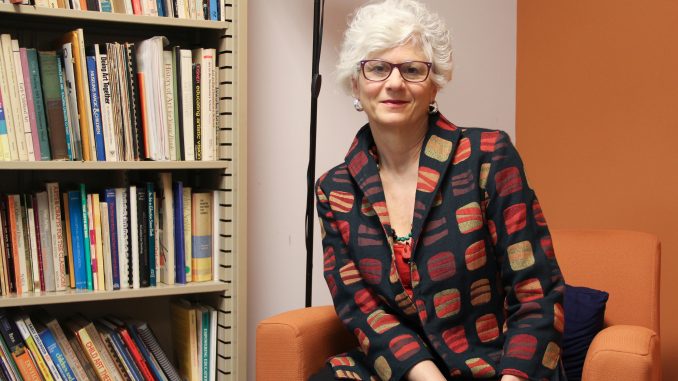
Dr. Lisa Kay believes people look at those with special needs as “us and them,” but “we’ve all had experiences with someone who has a disability or disorder,” she said.
The assistant professor in the department of art education and community arts practices earned her BFA in graphic design from the University of Memphis when she went on to earn her master’s degree and doctorate in art therapy. She said she has a “restless” personality, and needed to “do something new,” which is why she focused on art education for special needs children.
In March, Kay received the Peter J. Geisser Special Needs Art Educator of the Year Award in Chicago, which is given by three organizations: the National Art Education Association, the Council for Exceptional Children and VSA.
Receiving the award is meaningful for Kay because it’s “not just recognizing contributions to art education, but to the greater area of special needs and education,” she said.
While researching the intersection of art and education, Kay discovered that art teachers are often expected to do things that Kay did as a “clinician in a hospital,” she said.
“Art teachers are counselors, nurses and educators,” Kay said. “They do so many different things, but don’t get the right education to be able to work with many different kinds of children.”
At a young age, children who are “troubled” often end up in the art classroom, and that can be for a variety of reasons, Kay said. Sometimes administrators feel like there’s no other place to put them, and sometimes they’re there because it’s a “safe place” for them to express themselves, she added.
Art teachers could have many kids with different social, emotional and physical problems all in the same classroom, and they have to personalize lessons for each of them.
“I see art and education and therapy in these bubbles where they all kind of interact,” Kay said.
Every semester, Kay teaches “art for special needs” with student teachers at Temple, she said, and one of the projects she assigns is “visual notes.” These mini works of art examine the relationship between teachers and students with disabilities or special needs.
The assignment helps student teachers realize: there’s really no big difference between the teachers and the students, Kay said.
Her assignments help student teachers build empathy and compassion for the students they teach.
This approach comes from Kay’s art therapy background, because “as therapists, you always have to be thinking about your relationship with your clients or students,” she said.
Leslie Marie Grace, an art teacher who took Kay’s “Intro to Art Therapy” class, said that the class made her become more “reflective” on her current teaching, and more “cognitive” on what her students might be going through.
“We shared a lot of personal stories,” Grace said. “You have to be introspective of yourself, and understand what you’re going through to understand what your clients are going through.”
The most important thing Hailey Braham, a senior art education major, learned from Kay is that “everyone handles things differently,” she said.
“As teachers, we have to be the person that those kids can feel comfortable with, and be real people that they can relate to,” Braham added.
One of the most powerful experiences for Kay was working with a young woman with depression at a special education school, whose art pieces were accepted into a traveling art expedition called “Childhood Revealed: Art Expressing Pain, Discovery and Hope” through New York University Child Studies Center, which highlights the mental health needs of students. After the experience, the student told Kay she wanted to be an art therapist.
It taught Kay the importance of “viewing students as artists,” and not so much as hospital patients, she said.
And often, Kay said, the student teachers fall in love with the students and decide to earn their certifications in special needs education.
This isn’t unusual, she added. Kay has seen many students learn a lot about themselves while working with art, whether it’s creating art or teaching special needs students.
“If you’re going to be working with people, whether as a teacher or therapist, you’ve got to know yourself,” Kay said.
Tsipora Hacker can be reached at tsipora.hacker@temple.edu.


Be the first to comment